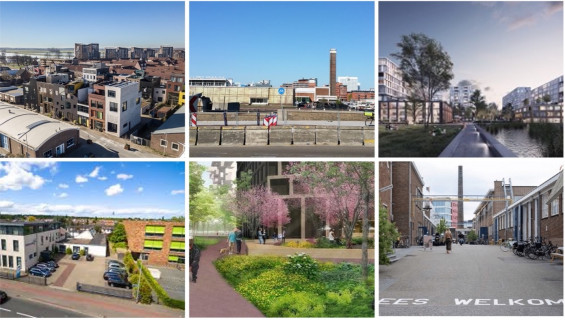This is the 21th episode of a series 25 building blocks to create better streets, neighbourhoods, and cities. Its topic is the combination of living and working in the same neighbourhood. This idea is currently high on the agenda of many city councils.
Benefits for the quality of the living environment
If there is also employment in or near the place where people live, several residents might walk to work. That will only apply to relatively few people, but urban planners think that bringing living and working closer together will also increase the liveliness of the neighborhood. But more reasons are mentioned: including cross-fertilization, sharing of spaces, the shared use of infrastructure (over time), a greater sense of security and less crime. Whether all these reasons are substantiated is doubtful.
In any case, mixed neighbourhoods contributes to widening the range of residential environments and there is certainly a group that finds this an attractive idea. The illustrations above show places were living and work will be mixed (clockwise): Deventer (Havenkwartier), The Hague (Blinckhorst), Leiden (Bioscience Park), Amersfoort (Oliemolenterrein), Amsterdam (Ravel) and Hilversum (Wybertjesfabriek).
Break with the past
Le Corbusier detested the geographical nearness of work and living. In his vision, all the daily necessities of residents of the vertical villages he had in mind had to be close to home, but the distance to work locations could not be great enough. Incidentally, very understandable because of the polluting nature of the industry in the first half of the 20th century. Nowadays, the latter is less valid. An estimated 30% of companies located on industrial sites have no negative environmental impact whatsoever. A location in a residential area therefore does not have to encounter any objections. The choice for an industrial site was mainly dictated because the land there is much cheaper. And that's where the shoe pinches. The most important reason to look for housing locations on industrial estates is the scarcity of residential locations within the municipality and consequently their high prices. Moreover, in recent decades the surface of industrial estates has grown faster than that of residential locations, at least until a couple of years ago.
Companies are still hesitating
Companies are generally reserved about the development of housing in their immediate vicinity. Apart from the realistic expectation that the price of land will rise, they fear that this will be at the expense of space that they think they will need to grow in the future. This fear is justified: In the Netherlands 4600 hectares of potential commercial sites disappeared between 2016 and 2021. Another concern is that future 'neighbors' will protest against the 'nuisance' that is inherent to industrial sites, among others because of the traffic they attract. The degree of 'nuisance' will mainly depend on the scale on which the mixing will take place. If this happens at block level, the risk is higher than in case of the establishment of residential neighborhoods in a commercial environment. But as said, there is no need to fear substantial nuisance from offices, laboratories, call centers and the like. Companies also see the advantages of mixing living and working, such as more security.
Searching for attractive combinations of living and working
Project developers see demand for mixed-use spaces rising and so do prices, which is an incentive for the construction of compact multifunctional buildings, in which functions are combined. To create sufficient space for business activity in the future, they advocate reserving 30% for business space in all residential locations. The municipality of Rotterdam counters this with a 'no net loss' policy regarding gross floor surface for commercial spaces.
Gradually, attractive examples of mixed living and working areas emerge. Park More (from Thomas More), the entrance area of the Leiden Bioscience Park, which will consist of homes, university facilities and a hotel (photo top right). The idea is that in the future there will also be room for the storage of rainwater, the cultivation of food and the production of the estate's own energy.
Another example, which can probably be followed in more places, is the transformation of the Havenkwartier Deventer into a mixed residential and working area, although part of the commercial activity has left and the buildings are being repurposed as industrial heritage (photo above left). The starting point is that, despite hundreds of new homes, the area will retain its industrial and commercial character, although some residents complain about the 'smoothening' of the area'. Living and working remains a challenging combination, partly depending on where the emphasis lies. In this respect, many eyes are focused on the substantiation of the plans of Amsterdam Havenstad.
Follow the link below to find an overview of all articles.





